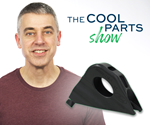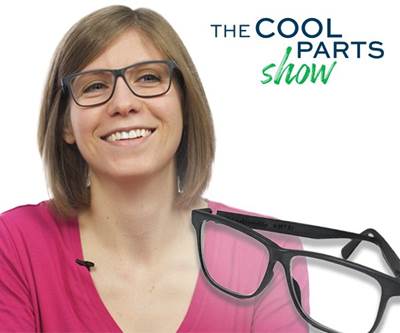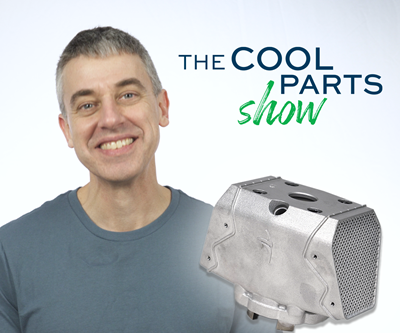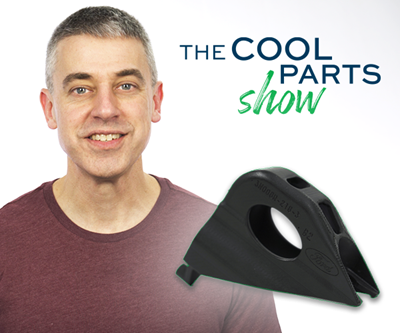Video: Carpenter Technology’s Company-Wide Response to COVID-19
Here are tactics the company has put in place to keep its team members safe as production continues despite the threat of the coronavirus. (Sponsored)
Carpenter Technology, the parent company of Carpenter Additive, reorganized in response to the coronavirus threat. In a literal sense, the company wrote the book on COVID-19 safety, because producing a handbook on new procedures and distributing it throughout the company was part of the response. Peter Zelinski of Additive Manufacturing had a conversation with Carpenter Chief Technology Officer David Graf about the tactics that Carpenter has deployed to keep employees safe while the company’s work continues in spite of the virus.
.
Transcript
Peter Zelinski, Additive Manufacturing
David, the COVID-19 crisis becomes apparent and Carpenter Technology continues as an essential manufacturer. So what became clear to the company at that point, what did company leaders realize needed to happen or they needed to do in order to empower employees to keep functioning effectively?
David Graf, Carpenter Technology
That was a very interesting time, those first two weeks in March, right as we were watching the pandemic come to root in the US, and we were watching the rules come out in the different states. We were watching all the details come out and we realized really quickly at that point, we had to not just act, but we had to take the offensive and go proactive. So what we decided we had to do is create a crisis team. This team was dedicated to setting our processes or protocols or procedures, basically lining out what we had to do in all of our mills and all of our plants in order to be able to drive this. And furthermore, to make clear the importance of this, my boss, Tony Thene, who's our CEO, took over the responsibility to run this program. So we knew right then and there, we had to act quick. The next thing we did was we basically said, what are we going to lay out for our employees? And within a day, we had basically said, we're going to send everybody home to work remotely who can work remotely. The next thing we did was we laid out layers of protections for all our plants. We said those people who have to go to work, we're going to protect them by not sending people to work with don't have to be there. And now we're going to layer on protections on top of each other. It's kind of an industry standard, but we took it to another level for COVID. You know, we have basically six layers of protection we put in for our plants. The first layer was the same thing we hear about everywhere. It's social distancing. It's washing hands to keep people safe from each other. But our second layer was very important. It's the self-reporting layer. We told our employees, hey, if you're home, and you feel sick, then call; don't come to work. If you're sick at work, tell us. We'll make sure we take care of you. But we need you to report if you feel sick. If you show any symptoms of COVID, we need to know about it so that we can protect you and can protect your fellow colleagues. And the important thing we did is we told them, if you're sick, we're going to pay you for 21-day isolation while you're out. We will pay to keep you safe and your colleagues safe. So those are two big steps. Then we got into our third and our fourth layers. In our third layer we basically put gates on all our plants, and people who came in had to answer a screening protocol. You know, did you show symptoms today, were you around somebody who showed symptoms. And they had their temperature checked. So nobody got on the site without going through those procedures. And if they've shown any symptoms, we sent them home immediately and had them self-report. Then we had this fourth and fifth layer that we've installed now, which is basically modularization of the plant. We carved out areas of the plant that are separate from each other. And then within those plants, we have pods of people that act and work separate from each other. So we really compartmentalized our operations to minimize any potential crosstalk, any potential cross contamination between people, pods and areas. And then in the sixth one, we created a hard, fast rule. Nobody's going to move between pods without the approval of a medical doctor, a business director and an executive. So we laid this down very hard on the rules around pods and modulizations. And then we've got a couple other layers that we put in after that. One of those is in certain states, we all have to wear face masks. In Pennsylvania, it's a rule. So we handed out face masks to all the employees to make sure they have that layer. In addition, all of our vendors who came on site, whether they were DHL, FedEx, others like that, they had to go through the screening at the gate to prove they were not sick or weren't exposed. All those layers basically have created the environment that we went aggressive on. And I think if you look at those layers, we really did go on the offensive. And we've laid down a really tight network that has kept our people safe.
Peter Zelinski
And that's a lot of employees you're talking about. As you alluded to, there are different states you're operating in. Just describe the scale of the challenge there, the challenge of implementing that response. Carpenter technology includes how many people, how many facilities?
David Graf
We have 5,000 people globally, across 10 major sites in the US, in Alabama, Pennsylvania, and South Carolina, a couple sites in Europe and in multiple small production distribution sites across the globe. So we had to develop rules and procedures that meet the US requirements and the European requirements, and they had to be adaptable to different languages in different situations. So we were able to push all that through, through that rapid response team. It was a daunting task, but we were able to get it done.
Peter Zelinski
One of the products of that response is this manual. The employees all got this, produced very quickly. Tell me about what is this book? How did this come about?
David Graf
This is actually the sum of all of the procedures and all the programs that the rapid response team put together. It covers every procedure, process and protocol that we have our employees follow, that we have our site leaders follow, and it encompasses the A to Z, basically, of our program. It's not static in that we will keep updating it as new rules come in. But it is basically our playbook for how do we handle COVID, the COVID crisis.
Peter Zelinski
What are some of the things employees learn by reading that manual? Maybe focus on a couple areas that feel kind of significant?
David Graf
I think there are two areas. One is a core value of our company: transparency. We have all the policies and procedures for all our employees to see what we do. We wanted them to understand what the medical part was about for their health screening. So in there, there are procedures about what is medical going to do if you self-report, what kind of data do they need? What are they going to do with that data? And who are they going to talk to about it? Then there are procedures about if you self-report outside of work, what do we do? If you self-report at your work and you felt sick after you are on shift, what do we do? And then how do we handle those situations? So that transparency around the medical part of the conditions is one of the big things and it dovetails to a second part of the puzzle, which is, what do we do with the facilities when somebody does self-report? We have whole procedures in there on how we clean the facility. What are the PPE aspects of it? Who does what, what are the procedures required to make sure that the facility has been cleaned so that the next day if somebody comes back to work, they can be guaranteed that the facility is as clean as it possibly can be, and the risk of COVID infection is gone. That's really the two parts of this puzzle that are important for employees to know.
Peter Zelinski
You mentioned pods, workspaces organized into pods. What is a pod? How does a pod work?
David Graf
A pod is basically the smallest group of people you can put together that have to work in one area. Typically, that could be five people, some pods are two, some pods are one. We try to keep them in that small group. It's a group of people that basically come on shift together, they have lunch break together with social distancing, they use different restrooms from everyone else. And they have their whole life at work involved with themselves. That pod never crosses lines with another pod. And we have multiple pods that way so that if somebody within a pod reports, self-reports that they're ill, we know exactly who they've worked with, and we can warn the rest of the pod to keep a close eye on them. But we also know then that if that person is in that pod, they didn't infect another pod. So it's really just that small nucleus of a work group, as small as we can go for individual areas so we can basically protect smaller groups of people and protect the overall company.
Peter Zelinski
Companies doing business with Carpenter, whether it's Carpenter Additive, Carpenter Technology, what should they understand about this? How does your response to COVID-19 internally connect to customers?
David Graf
So I think there's two ways to look at it. I look at it as our customers who we supply and the people that we work with that supply us. Our customers we supply see a company that’s been agile, that’s been ahead of the regulations and rules, that stayed safe and healthy, and has been able to provide and continue to provide for our customers and for our employees. For them, that's very important. They know that we're a stable force that can be there to help them now and through the future. Our suppliers and our vendors who work with us see that we have high expectations on safety, and we relay that to them. Anywhere our groups overlap, such as deliveries, supports, materials coming in, we explain what the expectations is for the COVID response to our suppliers, and they need to either be at the same level or exceed what we expect for the safety protocols. So our suppliers understand that we're not going to accept the lower quality materials and the lower quality responses to COVID. But they also understand that they're going to have a partner that's going to be there after this is done. I think in the end, both customers and our supply chain will be better off when we're all done with this and we get to our new normal.
Peter Zelinski
David Graf of Carpenter Technology. David, thank you for this perspective.
David Graf 09:20
Thank you for taking the time. I appreciate it.
Related Content
ActivArmor Casts and Splints Are Shifting to Point-of-Care 3D Printing
ActivArmor offers individualized, 3D printed casts and splints for various diagnoses. The company is in the process of shifting to point-of-care printing and aims to promote positive healing outcomes and improved hygienics with customized support devices.
Read More3D Printing with Plastic Pellets – What You Need to Know
A few 3D printers today are capable of working directly with resin pellets for feedstock. That brings extreme flexibility in material options, but also requires greater knowledge of how to best process any given resin. Here’s how FGF machine maker JuggerBot 3D addresses both the printing technology and the process know-how.
Read MoreVideo: 5" Diameter Navy Artillery Rounds Made Through Robot Directed Energy Deposition (DED) Instead of Forging
Big Metal Additive conceives additive manufacturing production factory making hundreds of Navy projectile housings per day.
Read More3D Printed Titanium Replaces Aluminum for Unmanned Aircraft Wing Splice: The Cool Parts Show #72
Rapid Plasma Deposition produces the near-net-shape preform for a newly designed wing splice for remotely piloted aircraft from General Atomics. The Cool Parts Show visits Norsk Titanium, where this part is made.
Read MoreRead Next
3D Printed Custom Glasses: The Cool Parts Show #8
Fitz Frames has reimagined glasses, from the frames to the ordering process. See how the company manufactures glasses customized to every face in this episode of The Cool Parts Show.
Read More3D Printing Changes a Drone Engine: The Cool Parts Show #9
Cobra Aero made the engine cylinder of an unmanned aerial vehicle (UAV) both more powerful and easier to manufacture. Learn what additive manufacturing is doing for drones in this episode of The Cool Parts Show.
Read More3D Printing for Production at Ford: The Cool Parts Show #7
The parking brake bracket on the Mustang Shelby GT500 is now 3D printed instead of stamped. Learn how Ford is thinking about additive manufacturing in this episode of The Cool Parts Show.
Read More
















